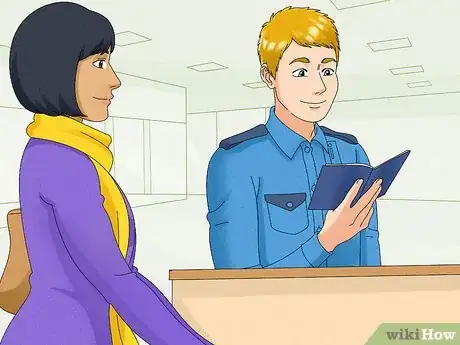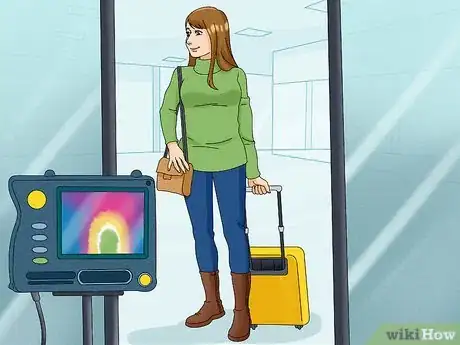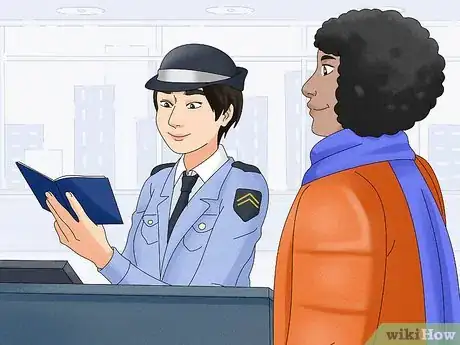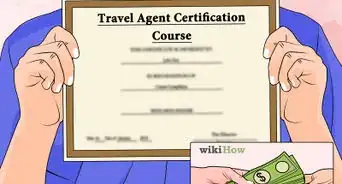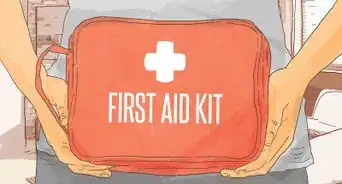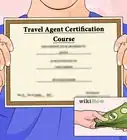This article was co-authored by Amy Tan. Amy Tan is a Travel Planner and the Founder of Planet Hoppers, a boutique travel design team founded in 2002. Planet Hoppers specializes in brainstorming and creating itineraries for dream vacations, honeymoons, exotic adventures, family reunions, and group trips. Planet Hoppers is a TRUE accredited travel agency and a member of the Signature Travel Network, the Cruise Lines International Association (CLIA), and Travel Leaders. Amy earned a BA in Communications and a BS in Physics from the University of California, Davis in 2000.
This article has been viewed 15,896 times.
Flying international can be an exciting and a new experience. For most people, your journey starts at the airport, but know that if you are crossing borders, you may need a passport depending on which country you are entering. Whether you are moving to a new country or exploring an unfamiliar landscape, you want international travel to be as smooth as you want it to be. This wikiHow aims to give a brief overview of the whole process of going international.[1]
Steps
Planning
-
1Obtain a passport/visa. Unless if you are flying between member European Union countries, you will need a passport and/or a visa to enter your country. If you need a visa, you will need to opt for a passport book, not a passport card.
- Even if you are flying within the European Union, if you cross country borders, you will still have to clear customs.
-
2Conduct research on your destination. Learn more about the culture and popular tourist spots. After all, the last thing you want to do is go to South Africa not knowing what to do. It will also make sure that you do not end up travelling somewhere barren or where tourism is not prevalent.
- This is also a good time to get a basic grasp of the language your country speaks, although since English is a global lingua franca, it should not be too difficult to find a tour or an attraction with English speakers.
- If moving, you will want to get started on your new language well before moving day.
Advertisement -
3Purchase tickets online or with a travel agent. In order to fly international, you will need to purchase a ticket. You can use Expedia or your search engine to find flights between two destinations. For the best experience, you will want to minimize the number of stops.
You may find it more comfortable to fly first class, as you may also gain access to a concierge lounge and more comfortable seating. Be warned, though: it will not be cheap to fly first (or business) class and some airlines restrict the lounges to participants in their frequent flyers programs.
-
4Arrange a means of transport. Some cities have a good public transportation system, like the Berlin U-bahn/S-bahn or the NYC Subway. Others don't, so you will have to rely on taxis and rental cars to get where you need to go.[2]
-
5Get accommodation at your destination. If moving, you may already have accommodation, but you will need to get a hotel room or suite if you are just visiting the country.[3] Know that some countries and hotels set a limit (usually 2-4 for hotel rooms) on the number of guests that can stay in an individual room, so you may need to acquire multiple (sometimes connecting) rooms.
-
6Determine what you can bring between the two countries. For example, some drugs that are legal in the United States are illegal in Japan. Other countries, like Saudi Arabia, set harsh penalties for violating immigration laws, from deportation to death. Entering a foreign country implies that you will follow that country's laws and norms, even if you do not agree with them.
- Also check currency limits. In the United States, for example, you must report to customs if you enter or leave the country with more than US$10000. And do not think about finding loopholes; the law most likely covers every edge case.
-
7See if you qualify for expedited security screening. This will reduce the time spent in the security lane when you arrive at the airport and will increase the time spent shopping duty free or enjoying a hearty breakfast from Starbucks. After check-in, see your boarding pass. If you see "Expedited screening" or "TSA precheck" printed on your boarding pass, you qualify for expedited screening.
Arriving at the Airport
-
1Verify that you have all necessary documents. Make sure that you have all important documents with you before you arrive at the airport to avoid a hassle later on when you check in.
-
2Arrive a few hours before your flight departs. This will give you time to relax on the ground and avoid hassles with luggage, security, and check-ins. It will also give you more time to research the area as well as enjoy a meal prior to departure.
-
3Check in at the check-in desk. Check in should be a streamlined process. Have your passport handy. They will also handle luggage for you and give instructions on getting to your departure gate.
- You will have a better time if you are travelling light. Some airlines even put a limit of 23 kilograms (51 lb) for checked bags; go over that limit and expect to pay additional fees. Still, your experience will be smoother if you only have carry-ons.
- Keep your passport with you as you will have to repeatedly undergo passport control several times.
Some airlines offer mobile or curbside check-in that you may want to use to skip the line.
-
4Enter the first round of passport control. Before you can go through security, you will need to show your passport and/or visa to the security officers. This is procedural and is done to make sure that you are who you are and that you are authorized to depart the country.
- Some countries (like Israel) also do an additional security interview; during this process, you will be asked a few questions ranging from public, general questions to private, personal questions. This is a probabilistic assessment done to determine the risk you pose to other passengers on your flight.
-
5Clear security. If you qualify for expedited screening, you will be directed to a separate lane. Security will also help identify potential hazards to the aircraft. Obviously, you cannot carry weapons or explosives onboard an airplane, but other everyday items, such as certain aerosol containers or kitchen utensils, can also be a potential hazard to passengers onboard. Prohibited items will either have to be discarded or moved between your checked luggage and carry-on, depending on the item and the hazards it may pose to people onboard.
Before Your Flight
-
1Shop duty-free. At the airport, you will be able to acquire a lot of items duty-free before leaving the country, significantly reducing the price of otherwise expensive goods. Note that you will not be able to use these items until you clear customs in your destination country.
-
2Enjoy the airline lounge if you qualify. In the lounge, you will be able to unwind prior to your journey. Some of the services offered include free meals, free beverages, a quiet area to sleep, more private toilets, showers, and what you may find in your own home. You may also get free Wi-Fi and some of the finest cuisine.
- For the comfort of all passengers in the lounge, no audible announcements will play to inform you of your flight. It is your responsibility to check the information displays in the lounge and the concierge desk for updates to your flight status and departures.
-
3Dine in and shop before your journey. Even if you cannot get a lovely place to get comfortable prior to your flight, you can still dine at one of the airport's restaurants. Some airports have different unique amenities that you can use while still on the ground.
-
4Arrive at the gate 15 minutes prior to boarding. Thirty minutes prior to boarding, you should start making your way to the gate. That way, you can make your flight on time and avoid rebooking your tickets.
Some airlines have first and business class boarding directly from the lounge.
-
5See if you qualify for pre-boarding. If you have medical conditions (like allergies), have a disability, or are travelling with young children, you should pre-board to ensure that the crew on board are aware of your medical conditions.
-
6Identify your boarding group. This should be printed on your ticket. Different airlines have different methods for boarding that you need to be aware of so you know when to board.
- The most common boarding method has first then business class board first, then subsequent groups in numerical or alphabetical order board one after the other. When your group is called, line up to prepare to board.
- Some airlines like Southwest allocate both a group and a position in the queue. The higher the boarding number, the closer you need to be to the front of the line.
- Other airlines do not use boarding groups and just have people board in whatever order they show up in.
- The gate closes several minutes prior to departure. If you are hearing "final boarding call", you need to hurry onto the airplane to keep your seat.
During Your Flight
International flights can be long and boring, so you want to keep yourself entertained.
-
1Enjoy a meal or a beverage. Depending on your time zone of departure, the airline will serve either breakfast, lunch, or dinner after reaching cruising altitude. For overnight flights, lunch or dinner will be served first. The lights in the cabin will be dimmed in the evening and turned off when everyone is sleeping, and the flight attendants will wake everyone up for breakfast before arrival.
- Make your breakfast choices at the beginning of your flight before takeoff. You will need to do so so that everyone can get it. Breakfast is not free and will probably not be grand unless in first class.
-
2Browse the in-flight entertainment. Depending on your flight, you will gain access to certain movies and TV shows to keep you busy when there is nothing to do. Enjoy content ranging from 720p in economy to 4K in first class.
-
3Download content to your phone or computer prior to takeoff. Unless if you want to pay for Wi-Fi, you will not gain access to anything online after departing from the airport. Certain offline games (like Minecraft or FIFA) are also great for long flights.
- You may also want to bring a book with you in case your computer dies, although it is rare to be on an international flight with no charging power.
-
4Get some sleep. Some international flights can be up to 18 hours long, meaning you will probably feel more refreshed before landing if you sleep. Know that if you crash, you might not wake up until the end of the flight.
- Avoid staying up your entire flight as you will feel tired and groggy when you land at your destination. It is best to get some rest while in the air to avoid crashing at the last minute.
-
5Be courteous to others. Close the window shutters during sleeping time and leave the airplane lavatory spotless as if it was your home. Doing so improves the experience of the flight for everyone.
- The light outside can be too bright for both you and other passengers, so respect the bed time and do not use the windows as a source of light. Instead, use the more directional reading lamps if you need a light source.
-
6Complete all immigration forms. Prior to landing, you must fill out a customs and immigration form from the destination country. You must complete them so you can pay the appropriate customs duty and verify that you are not importing anything illegal.
After Your Flight
-
1Complete the second round of passport control. After arriving, you will need to complete passport control again. This time, the destination country is verifying that you have all the appropriate documents needed to enter.
- Some countries may allow you to obtain a visa right before passport control, although it may be more expensive and is not a guarantee that you will be allowed to enter. Other countries have digital visas that you can print at home and staple into your passport.
- If you have a connecting international flight, you will most likely not have to go through passport control; instead, head to the check-in desk for your connecting flight or follow the signs up to the departures floor. Note, however, that CCTV and security/customs agents may monitor your movements, and if you leave the sterile area without clearing customs and immigration, you will be detained.
-
2Claim your baggage. If you checked any luggage in with your airline, you will need to claim it. This is because you will need to have your belongings checked by customs.
-
3Identify whether you have items to declare. You will know either because an immigration officer told you, you marked an option saying that you had to declare something, or because you have an item that is either prohibited or subject to customs duty. If you do not have an item to declare, have your baggage X-rayed in the green lane then head out of the airport towards public transportation and car rentals. If you do, then proceed through the red lane where a customs officer will open your baggage and charge the appropriate duties.
-
4Meet with your arranged means of transportation. They will take you to your accommodation in your destination country.
-
5Overcome jet lag. Unfortunately, sudden changes in time zones can disrupt normal sleep/wake patterns. Therefore, in order to be more productive, you will need to overcome jet lag to enjoy your journeys in the country. This takes from a few days to a few weeks.
Community Q&A
-
QuestionFor first class, can you turn your seats into a bed?
 AasimTop AnswererIn some cases, yes. Turkish Airlines, Emirates, Delta, and United are a few airlines that have super comfortable first class seating on international flights.
AasimTop AnswererIn some cases, yes. Turkish Airlines, Emirates, Delta, and United are a few airlines that have super comfortable first class seating on international flights.
Warnings
- You will want to locate the nearest embassy/consulate in case you need their diplomatic services (like a new passport or an evacuation flight back to your home country).⧼thumbs_response⧽
- Do not accept offers of transportation to or from the airport from someone you do not know. This is both for your physical safety and to avoid being scammed while abroad. Only use means of transport previously arranged with your travel agency or tour company.⧼thumbs_response⧽
- Be wary of pickpockets; they can be everywhere in crowded tourist spots. Keep your passport either in your hotel room or in a protected pocket.⧼thumbs_response⧽
References
- ↑ https://gizmodo.com/how-to-travel-internationally-for-the-very-first-time-1683522112
- ↑ Amy Tan. Travel Planner. Expert Interview. 12 March 2020.
- ↑ Amy Tan. Travel Planner. Expert Interview. 12 March 2020.











